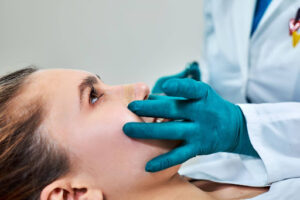Undergoing eyelid surgery, also known as blepharoplasty, can be a life-changing experience for many individuals. Whether it’s to correct sagging eyelids, remove excess skin, or improve the overall appearance of the eyes, this popular cosmetic procedure has gained immense popularity in recent years. However, before deciding to undergo eyelid surgery, it’s essential to have a comprehensive understanding of the recovery process.
Recovery plays a crucial role in any surgical procedure, and eyelid surgery is no exception. After all, the duration and quality of recovery can significantly impact the final outcome and overall satisfaction with the procedure. From managing swelling and bruising to allowing the incisions to heal properly, the recovery period requires patience, proper care, and adherence to the post-operative instructions provided by your surgeon. In this blog, we delve into the factors that affect the duration of recovery from eyelid surgery and offer some insights into what you can expect during this critical healing phase.
What Is Eyelid Surgery?
Eyelid surgery, also known as blepharoplasty, is a common procedure performed to improve the appearance of the eyelids. It involves making incisions in order to reposition or remove excess fatty tissue, muscles, and skin that cause the eyes to look puffy or droopy.
The incision pattern can vary depending on the type of surgery. For upper eyelid surgery, it is usually along the natural crease line and for lower lids it is usually beneath the lashes. Following this, all excess skin and fat are removed or redistributed to give you a fuller-looking yet smoother surface around your eye.
The main goal of eyelid surgery is to rejuvenate and improve the overall appearance of the eyes. By removing excess fat, tightening overtight muscles, and removing excess skin, eyelid surgery can give you a youthful look. The result of this intervention is a better balance of the face where the eyes appear wider, brighter and more open. It is usually combined with neuromodulators for optimal results.
Facts about blepharoplasty you should know
What To Expect From The Recovery Process
Recovery after eyelid surgery is generally well tolerated, with varying times depending on the individual and the extent of the procedure. The process is broken down into three parts (bruising, swelling and maturing of the incision/scar), each of which has its own time frame.
The Day of Surgery
After the procedure, you’ll be carefully monitored by nurses in a recovery area to ensure your comfort and well-being. Immediate postoperative care for eyelid surgery is crucial for a smooth recovery. To promote healing and reduce swelling, it’s important to keep your head elevated with pillows while resting. This helps improve blood flow and decrease fluid accumulation around the surgical site.
During this time, you may experience some discomfort or tightness in your upper eyelids. It’s normal to have some bruising and swelling after the surgery, but these symptoms will gradually subside over time. To alleviate pain and aid in healing, your doctor may prescribe pain medication or recommend over-the-counter pain relievers.
In terms of physical activity, it’s best to avoid strenuous exercise or activities that could strain the eye area during the initial stages of recovery. Give yourself ample time to rest so that your body can heal properly. Be patient with the recovery process as it typically takes several weeks for complete healing and optimal results from eyelid surgery.
The First Week After Surgery
During the days after surgery, you’ll need to take it easy and rest to minimize swelling or discomfort. It’s important to listen to your body and not push yourself too hard. Avoid strenuous activities or heavy lifting during this time, as it can delay the healing process. In addition to rest, there are other measures you can take to manage discomfort and swelling. Your doctor may prescribe pain medications to help alleviate pain following a blepharoplasty procedure.
It is important to take these medications as directed and not to skip doses. Using a cold compress on the treated area can also help reduce swelling and relieve pain. Do not apply too much pressure or leave the cold compress on too long, as this may damage the delicate skin around the eye area. Antibiotic or silicone ointment should also be applied frequently to keep the incision moist for optimal healing during the first week.
Two To Four Weeks After Surgery
In this stage of the recovery process, you should start to notice significant improvements in the healing process. Swelling and bruising should begin to subside, although some residual swelling may still be present. Your incisions will also continue to heal during this time, gradually becoming less noticeable over the coming weeks. While you may be feeling better during weeks 2-4 after eyelid surgery, it’s essential to avoid strenuous daily activities that could strain your eyes or disrupt the healing process.
Following postoperative instructions provided by your surgeon is vital for optimal results. Remember that each individual heals at their own pace, so don’t compare your progress with others who have undergone similar cosmetic procedures or facial surgeries like upper blepharoplasty. Resting adequately and following proper aftercare will help ensure a successful recovery from eyelid surgery in the long run.
One To Three Months After Surgery
As you approach the one to three-month mark, you’ll be amazed at the final results and your progress in achieving your desired appearance. By this time, your eyelid surgery recovery will be well underway, and you’ll notice that any swelling or bruising has virtually disappeared. Your eyelids will start to look more natural and rejuvenated, enhancing your overall facial appearance.
A VBEAM laser treatment can optimize the appearance of the scar and helps the redness dissipate faster, and is usually performed at this point. During this phase of recovery, it’s important to attend follow-up visits scheduled with your surgeon. These visits allow them to monitor your progress and ensure that everything is healing properly. Your surgeon may also provide additional instructions on how best to care for your eyes during this time.
They may recommend certain eye drops, antibiotic ointments, or creams to aid in the healing process. You can also begin to gradually increase your activity level but still prioritize restful sleep. It’s essential to listen to your body and avoid overexertion as it can delay the healing process. If you have any concerns or questions about how much physical activity is appropriate for you during this stage, don’t hesitate to reach out to your surgeon for guidance.
Long-Term Recovery
As part of long-term recovery, you may have follow-up visits with your surgeon to monitor progress and address any concerns. These appointments allow your surgeon to ensure that your healing process is going smoothly and intervene if necessary. Your surgeon may also provide recommendations on scar management techniques, such as applying silicone gel or sheets, which can help minimize scarring during the recovery period.
Managing scarring is an important aspect of long-term recovery from eyelid surgery. While some scarring is inevitable, there are steps you can take to promote optimal healing and reduce its visibility over time. Avoiding excessive sun exposure and wearing sunscreen when outdoors can protect the delicate skin around your eyes from UV damage, which can worsen scars. Additionally, massaging the incision sites gently with a moisturizer or scar cream as advised by your surgeon can help break down scar tissue and improve their appearance.
Tips for a Smooth Recovery
Follow Your Surgeon’s Instructions
Your surgeon will provide you with a set of post-operative instructions tailored to your specific needs. It’s crucial to follow these instructions diligently to ensure a smooth recovery. They may include guidelines for medication, wound care, avoiding certain activities, and attending follow-up appointments. By adhering to these instructions, you can promote proper healing and minimize the risk of complications.
Take Care Of Your Incisions
Proper care of your incisions is essential for a successful recovery. Keep the surgical area clean and follow the recommended cleansing routine provided by your surgeon. Avoid rubbing or scratching the incisions to prevent infection or disruption of the healing process. Apply any prescribed ointments or dressings as directed.
Manage Swelling And Bruising
Swelling and bruising are common after eyelid surgery. To minimize these effects, use cold compresses or ice packs as recommended by your surgeon. Cold therapy can help reduce inflammation and alleviate discomfort as well as Arnica based creams or gels. Additionally, keeping your head elevated while resting or sleeping can aid in reducing swelling.
Take it easy and rest
Allow yourself ample time to rest and recover after eyelid surgery. Engage in light activities and avoid strenuous exercises or activities that can strain the eyes or incisions. Taking time off from work or any demanding responsibilities can promote a faster recovery and ensure optimal healing.
Maintain a healthy lifestyle
A well-balanced diet and a healthy lifestyle can contribute to a smoother recovery process. Make sure to eat nutritious foods that promote healing, such as fruits, vegetables, lean proteins, and whole grains. Stay hydrated, avoid smoking, and limit alcohol consumption as these factors can negatively impact the healing process.
Protect your eyes from the sun
Exposure to the sun’s harmful rays can lead to prolonged swelling and delayed healing. Protect your eyes by wearing sunglasses with UV protection when you’re outside and hats that protect your face even on cloudy days. This precaution will not only aid in your recovery but also protect your eyes from potential damage.
Be patient and realistic
It’s important to have realistic expectations about the recovery process. Swelling and bruising may take several weeks to fully subside, and the final results may not be immediately apparent. Give your body the time it needs to heal and consult with your surgeon if you have any concerns or questions along the way.
Book an Eyelid Surgery Consultation in Montreal
Committing to eyelid surgery is a great way to achieve a more youthful and rejuvenated look, but it is essential that you seek the services of a reputable cosmetic clinic to perform the procedure. A double-board certified facial surgeon such as Dr. Moubayed will ensure that the procedure goes smoothly and you leave with the new appearance you were hoping for.





